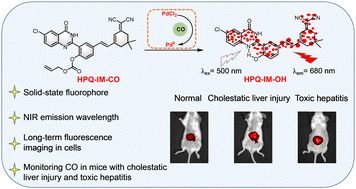Carbon monoxide (CO) is an important gas transporter and is closely related to a variety of physiological and pathological processes. Many fluorescent probes have been prepared for detecting CO, but most of them suffer from water-soluble fluorophores, which diffuse easily and are limited for application in vivo. Herein, a new solid-state fluorophore (HPQ-IM-OH) is prepared by introducing isophorone to HPQ, which has a long emission wavelength (680 nm) and good diffusion-resistance ability. The solid-state fluorescent probe (HPQ-IM-CO) is constructed using the allyl formate group as a recognition group for CO. The probe itself does not exhibit fluorescence. When CO and Pd2+ are added, HPQ-IM-OH is released. The photoinduced electron transfer (PET) process is turned off, and the excited-state intramolecular proton transfer (ESIPT) process is turned on, emitting a strong solid-state fluorescence signal. Due to low cytotoxicity, HPQ-IM-CO can be used to detect exogenous and endogenous CO in cells and is capable of imaging over long periods. In particular, the probe can be used for long-term imaging of CO up-regulation in cholestatic liver injury, and it can also be used for long-term imaging of CO up-regulation in toxic hepatitis, and the therapeutic effects of three hepatoprotective drugs (NAC, DDB and GSH) can be assessed.
